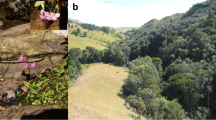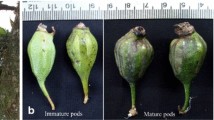Abstract
Orchid–mycobiont specificity in the Orchidaceae was considered controversial and not well understood for many years. Differences in mycobiont specificity during germination in vitro vs in situ have lead some to consider orchid–mycobiont specificity as being generally low; however, others have suggested that specificity, especially in vitro, is surprisingly high. Mycobiont specificity may be genus or species specific. An in vitro symbiotic seed germination experiment was designed to examine mycobiont specificity of the endangered Florida terrestrial orchid Spiranthes brevilabris using mycobionts isolated from both the study species and the endemic congener Spiranthes floridana. In a screen of mycobionts, isolates Sflo-305 (99.5%), Sflo-306 (99.5%), and Sflo-308 (89.9%) (originating from S. floridana) supported higher initial (stage 1) seed germination than isolate Sbrev-266 (32.4%) (originating from S. brevilabris) after 3 wk culture. However, only isolate Sbrev-266 supported advanced germination and protocorm development to stage 5 (53.1%) after 12 wk culture. These findings suggest that S. brevilabris maintains a high degree of mycobiont specificity under in vitro symbiotic seed germination conditions. High orchid–mycobiont specificity in S. brevilabris may be indicative of the rare status of this orchid in Florida.




Similar content being viewed by others
References
Anderson, A. B. Symbiotic and asymbiotic germination and growth of Spiranthes magnicamporum (Orchidaceae). Lindleyana 6:183–186; 1991.
Anderson, A. B. The reintroduction of Platanthera ciliaris in Canada. In: Allen, C., ed. North American native terrestrial orchids: propagation and production. Washington D.C.: North American Native Terrestrial Orchid Conference; 1996:73–76.
Arditti, J. Orchids. Sci. Am. 214:70–78; 1966.
Batty, A. L.; Brundrett, M. C.; Dixon, K. W.; Sivasithamparam, K. New methods to improve symbiotic propagation of temperate terrestrial orchid seedlings from axenic culture to soil. Austr. J. Bot. 54:367–374; 2006a.
Batty, A. L.; Brundrett, M. C.; Dixon, K. W.; Sivasithamparam, K. In situ symbiotic seed germination and propagation of terrestrial orchid seedlings for establishment at field sites. Austr. J. Bot. 54:375–381; 2006b.
Bidartondo, M. I.; Bruns, T. D. On the origins of extreme mycorrhizal specificity in the Monotropoideae (Ericaceae): performance trade-offs during seed germination and seedling development. Mol. Ecol. 14:1549–1560; 2005.
Brown, P. M. Wild orchids of Florida. Gainesville: University Press of Florida; 2002; 240–272.
Clements, M. A. Orchid mycorrhizal associations. Lindleyana 3:73–86; 1988.
Currah, R. S.; Sigler, L.; Hambleton, S. New records and new taxa of fungi from the mycorrhizae of terrestrial orchids of Alberta. Can. J. Bot. 65:2473–2482; 1987.
Currah, R. S.; Smreciu, E. A.; Hambleton, S. Mycorrhizae and mycorrhizal fungi of boreal species of Platanthera and Coeloglossum (Orchidaceae). Can. J. Bot. 68:1171–1181; 1990.
Currah, R. S.; Zelmer, C. D.; Hambleton, S.; Richardson, K. A. Fungi from orchid mycorrhizas. In Arditti, J.; Pridgeon, A.M., eds. Orchid biology: reviews and perspectives VII. Great Britain: Kluwer Academic Publishing; 1997; 117–170.
Curtis, J. T. The relation of specificity of orchid mycorrhizal fungi to the problem of symbiosis. Am. J. Bot. 26:390–399; 1939.
Davidson, R. W. Differentiation of wood-decaying fungi by their reactions on gallic or tannic acid medium. J. Agric. Res. 57:683–695; 1938.
Dixon, K. Raising terrestrial orchids from seed. In: Harris, W. K., ed. Modern orchid growing for pleasure and profit. Adelaide: Orchid Club of South Australia; 1987:47–100.
Hadley, G. Non-specificity of symbiotic infection in orchid mycorrhiza. New Phytol. 69:1015–1023; 1970.
Knudson, L. Non-symbiotic germination of orchid seeds. Bot. Gaz. 77:212–219; 1922.
Main, M. B.; Roka, F. M.; Noss, R. F. Evaluating costs of conservation. Conserv. Biol. 13:1262–1272; 1999.
Marshall, G. H.; Pielke, R. A. Has the conversion of natural wetlands to agricultural land increased the incidence and severity of damaging freezes in south Florida? Mon. Weather Rev. 132:2243–2258; 2004.
Masuhara, G.; Katsuya, K. Effects of mycorrhizal fungi on seed germination and early growth of three Japanese terrestrial orchids. Scitia Hort. 37:331–337; 1989.
Masuhara, G.; Katsuya, K. In situ and in vitro specificity between Rhizoctonia spp. and Spiranthes sinensis (Persoon) Ames var. amoena (M. Bieberstein) Hara (Orchidaceae). New Phytol. 127:711–718; 1994.
Masuhara, G.; Katsuya, K.; Yamagucki, K. Potential for symbiosis of Rhizoctonia solani and binucleate Rhizoctonia with seeds of Spiranthes amoena var. amoena in vitro. Myco. Res. 97:746–752; 1993.
McCormick, M. K.; Whigham, D. F.; Sloan, D.; O’Malley, K.; Hodkinson, B. Orchid–fungus fidelity: a marriage meant to last? Ecol. 87:903–911; 2006.
McKendrick, S. L.; Leake, J. L.; Taylor, D. L.; Read, D. J. Symbiotic germination and development of the myco-hetertrophic orchid Neottia nidus-avis in nature and its requirements for locally distributed Sebacina spp. New Phytol. 154:233–247; 2002.
Moore, R. T. The genera of Rhizoctonia-like fungi: Ascorhizoctonia, Ceratorhiza gen. nov., Epulorhiza gen. nov., Moniliopsis, and Rhizoctonia. Mycotaxon 29:91–99; 1987.
Otero, J. T.; Bayman, P.; Ackerman, J. D. Variation in mycorrhizal performance in the epiphytic orchid Tolumnia variegata in vitro: the potential for natural selection. Evol. Ecol. 19:29–43; 2005.
Phillips, J. M.; Hayman, D. S. Improved procedures for clearing roots and straining parasitic and vesicular–arbuscular mycorrhizal fungi for rapid assessment of infection. Trans. Br. Mycol. Soc. 55:158–160; 1970.
Rasmussen, H. N. Terrestrial orchids: from seed to mycotrophic plant. Cambridge: Cambridge University Press; 1995.
Richardson, K. A.; Currah, R. S. Basidomycetous endophytes from the roots of neotropical epiphytic Orchidaceae. Lindleyana 8:127–137; 1993.
SAS Institute Inc. SAS version 8.02. North Carolina: SAS Institute; 1999.
Selosse, M. A.; Wei, M.; Jany, J. L., Tiller, A. Communities and populations of sebacinoid basidiomycetes associated with the achlorophyllous orchid Neottia nidus-avis (L.) L.C.M. Rich. and neighbouring tree ectomycorrhizae. Mol. Ecol. 11:1831–1844; 2002.
Sharma, J.; Zettler, L. W.; Van Sambeek, J. W.; Ellerieck, M. R.; Starbuck, C. J. Symbiotic seed germination and mycorrhizae of the federally threatened Platanthera praeclara (Orchidaceae). Am. Midl. Nat. 149:104–120; 2003.
Shefferson, R. P.; Wei, M.; Kull, T.; Taylor, D. L. High specificity generally characterizes mycorrhizal association in rare lady’s slipper orchids, genus Cypripedium. Mol. Ecol. 14:613–626; 2005.
Smith, R. E. Rapid tube test for detecting fungal cellulase production. Appl. Environ. Microbiol. 33:980–981; 1977.
Smreciu, E. A.; Currah, R. S. Symbiotic germination of seeds of terrestrial orchids of North America and Europe. Lindleyana 4:6–15; 1989.
Stevens, R. B., ed. Mycology guidebook. Seattle: University of Washington Press; 1974; 703.
Stewart, S. L.; Kane, M. E. Symbiotic seed germination of Habenaria macroceratitis (Orchidaceae), a rare Florida terrestrial orchid. Plant Cell Tissue Organ Cult. 86:159–167; 2006.
Stewart, S. L.; Zettler, L. W. Symbiotic germination of three semi-aquatic rein orchids (Habenaria repens, H. quinqueseta, H. macroceratitis) from Florida. Aquat. Bot. 72:25–35; 2002.
Stewart, S. L.; Zettler, L. W.; Minso, J.; Brown, P. M. Symbiotic germination and reintroduction of Spiranthes brevilabris Lindley, an endangered orchid native to Florida. Selbyana 24:64–70; 2003.
Taylor, D. L.; Bruns, T. D. Independent, specialized invasion of ectomycorrhizal mutualism by two nonphotosynthetic orchids. Proc. Natl. Acad. Sci. U.S.A. 94:5410–5415; 1997.
Taylor, D. L.; Bruns, T. D. Population, habitat and genetic correlates of mycorrhizal specialization in the ‘cheating’ orchids Corallorhiza maculate and C. mertensiana. Mol. Ecol. 8:1719–1732; 1999.
Taylor, D. L.; Bruns, T. D.; Szaro, T. M.; Hodges, S. A. Divergence in mycorrhizal specialization within Hexalectris spicata (Orchidaceae), a nonphotosynthetic desert orchid. Am. J. Bot. 90:1168–1179; 2003.
Zelmer, C. D. Root-associated organisms of the Cypripedioideae (Orchidaceae). Ph.D. thesis, University of Guelph, Ontario, Canada; 2001.
Zelmer, C. D.; Currah, R. S. Ceratorhiza pernacatena and Epulorhiza calendulina spp. nov.: mycorrhizal fungi of terrestrial orchids. Can. J. Bot. 73:1981–1985; 1995.
Zelmer, C. D.; Currah, R. S. Symbiotic germination of Spiranthes lacera (Orchidaceae) with a naturally occurring endophyte. Lindleyana 12:142–148; 1997.
Zelmer, C. D.; Cuthbertson, L.; Currah, R. S. Fungi associated with terrestrial orchid mycorrhizas, seeds and protocorms. Mycoscience 37:439–448; 1996.
Zettler, L. W. Orchid fungal symbiosis and its value in conservation. McIlvaninea 13:40–45; 1997a.
Zettler, L. W. Terrestrial orchid conservation by symbiotic seed germination: techniques and perspectives. Selbyana 18:188–194; 1997b.
Zettler, L. W.; Hofer, C. J. Propagation of the little club-spur orchid (Platanthera clavellata) by symbiotic seed germination, and its ecological implications. Environ. Exp. Bot. 39:189–195; 1998.
Zettler, L. W.; McInnis, T. M. Propagation of Platanthera integrilabia (Correll) Luer, an endangered terrestrial orchid, through symbiotic seed germination. Lindleyana 7:154–161; 1992.
Zettler, L. W.; McInnis, T. M. Symbiotic seed germination and development of Spiranthes cernua and Goodyera pubescens (Orchidaceae: Spiranthoideae). Lindleyana 8:155–162; 1993.
Zettler, L. W.; Burkhead, J. C.; Marshall, J. A. Use of a mycorrhizal fungus from Epidendrum conopseum to germinate seed of Encyclia tampensis in vitro. Lindleyana 14:102–105; 1999.
Zettler, L. W.; Piskin, K. A.; Stewart, S. L.; Hartstock, J. J.; Bowles, M. L.; Bell, T. J. Protocorm mycobionts of the federally threatened eastern prairie fringed orchid, Platanthera leucophaea (Nutt.) Lindley, and a technique to prompt leaf elongation in seedlings. Stud. Mycol. 53:163–171; 2005.
Zettler, L. W.; Stewart, S. L.; Bowles, M. L.; Jacobs, K. A. Mycorrhizal fungi and cold-assisted symbiotic germination of the federally threatened eastern prairie fringed orchid, Platanthera leucophaea (Nuttall) Lindley. Am. Midl. Nat. 145:168–175; 2001.
Acknowledgements
The authors thank Tim Johnson (Environmental Horticulture Department, University of Florida) and James Kimbrough, Ph.D. (Plant Pathology Department, University of Florida) for their helpful reviews of this manuscript. Carrie Reinhardt Adams, Ph.D. (Environmental Horticulture Department, University of Florida) provided access to microscopic equipment. Appreciation is also extended to the San Diego County Orchid Society, the U.S. Fish and Wildlife Service—Florida Panther National Wildlife Refuge, and the Florida Division of Forestry for providing financial support of this research. Brand names are provided for references; the authors do not solely endorse these particular products.
Author information
Authors and Affiliations
Corresponding author
Additional information
Editor: B. R. Reed
Rights and permissions
About this article
Cite this article
Stewart, S.L., Kane, M.E. Symbiotic seed germination and evidence for in vitro mycobiont specificity in Spiranthes brevilabris (Orchidaceae) and its implications for species-level conservation. In Vitro Cell.Dev.Biol.-Plant 43, 178–186 (2007). https://doi.org/10.1007/s11627-006-9023-4
Received:
Accepted:
Published:
Issue Date:
DOI: https://doi.org/10.1007/s11627-006-9023-4




